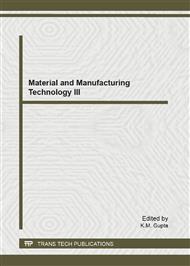[1]
Z. Pawlak. Rough sets. Internat. J. Comput. Inform. Sci. 11, 1982, p.341–356.
Google Scholar
[2]
Z. Pawlak. Rough sets: Theoretical aspects of reasoning about dat. Kluwer Academic Publishers, Boston, (1991).
Google Scholar
[3]
Z. Bonikowski,E. Bryniaski,U. WybraniecSkardowska. Extensions and Intensions in The Rough Set Theory. Information Sciences, Vol. 107, 1998, pp.149-167.
DOI: 10.1016/s0020-0255(97)10046-9
Google Scholar
[4]
R. Slowinski, D. Vanderpooten. A generalized definition of rough approximations based on similarity. IEEE Trans. On Knowledge and Data Engineering 12(2), 2000, p.331–336.
DOI: 10.1109/69.842271
Google Scholar
[5]
E. Tsang, D. Cheng, J. Lee, D. Yeung. On the upper approximations of covering generalized rough sets. In Proc. 3rd International Conf. Machine Learning and Cybernetics, 2004, p.4200–4203.
DOI: 10.1109/icmlc.2004.1384576
Google Scholar
[6]
F. Zhu. On covering generalized rough sets. Master's thesis, The University of Arizona, Tucson, Arizona, USA, May, (2002).
Google Scholar
[7]
J. T. Yao , Y. Y. Yao. Induction of classification rules by granular computing. In Rough Sets and Current Trends in Computing, 2002, p.331–338.
DOI: 10.1007/3-540-45813-1_43
Google Scholar
[8]
L. A. Zadeh. Fuzzy sets. Information and Control, 8, 1965, p.338–353.
Google Scholar
[9]
L.A. Zadeh. The concept of a linguistic variable and its application to approximate reasoning-I. Information Sciences 8, 1975, p.199–249.
DOI: 10.1016/0020-0255(75)90036-5
Google Scholar
[10]
William Zhu , Fei-Yue Wang. Reduction and axiomization of covering generalized rough sets. Information Sciences 152, 2003, p.217–230.
DOI: 10.1016/s0020-0255(03)00056-2
Google Scholar
[11]
William Zhu, Fei-Yue Wang,. A new type of covering rough sets. In IEEE IS 2006, London, 4-6 September, 2006, p.444–449.
Google Scholar
[12]
William Zhu, Fei-Yue Wang. Relationships among three types of covering rough sets. In IEEE GrC, 2006, p.43–48.
DOI: 10.1109/grc.2006.1635755
Google Scholar
[13]
William Zhu, Fei-Yue Wang. Three types of covering rough sets. to appear in Transactions on Knowledge and Data Engineering, 19, 2007, p.1131–1144.
DOI: 10.1109/tkde.2007.1044
Google Scholar
[14]
William Zhu, Fei-Yue Wang. Properties of the First Type of Covering-Based Rough Sets. in ICDM 2006 Workshop on Foundations of Data Mining and Novel Techniques in High Dimensional Structural and Unstructured Data, Hongkong, China, 18-22 December, 2006, pp.407-411.
DOI: 10.1109/icdmw.2006.136
Google Scholar
[15]
William Zhu. Properties of the Second Type of Covering-Based Rough Sets. in ICWI 2006 Workshop on GrC & BI, Hongkong, China , 18-22 December, 2006, pp.494-497.
Google Scholar
[16]
William Zhu, Fei-Yue Wang. Properties of the Third Type of Covering-Based Rough Sets. in ICMLC 2007, Hong Kong, China , 19-22 August, 2007, pp.3746-3751.
Google Scholar
[17]
William Zhu. Properties of the Fourth Type of Covering-Based Rough Sets. in HIS 2006, AUT Technology Park, Auckland, New Zealand, 13-15 December, 2006, pp.43-43.
Google Scholar
[18]
Mingfen WU, Xianwei WU, Ting SHEN, Cungen CAO. A New Type of Covering Approximation Operators. International Conf. Electronic Computer Technology, 2009, pp.334-338.
DOI: 10.1109/icect.2009.42
Google Scholar
[19]
Jiao Liu and Zuhua Liao. The Sixth Type of Covering-Based Rough Sets. IEEE INTERNATIONAL CONFERENCE ON GRANULAR COMPUTING, VOLS 1 AND 2, 2008, pp.438-441.
DOI: 10.1109/grc.2008.4664650
Google Scholar
[20]
Hu Jun, Wang Guo-Yin, Hierarchical model of covering granular space, JOURNAL OF NANJ IN G UNIVERSITY (NA TURAL SCIENCES), Vol. 44 , No. 5, Sept, 2008, pp.551-558.
Google Scholar


